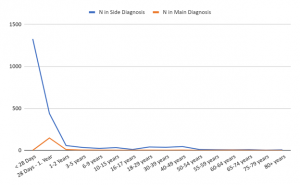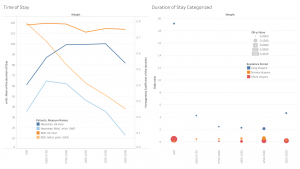ROP in Germany
Ahmad Alfaar, Melih parlak, Armin Wolf
Results:[edit | edit source]
Our study included 1,326 patients from 778,090 new births (as estimated by the Statistics office) or 795,132 admissions. Males represented 53.32% (N=707) , and females 46.68% (N=619). This represented 17.04 per 10,000 new births in 2019. The incidence was 17.71 in males and 16.34 in females.
The mean time for hospital stay was 79,5 days (SD = 33.7). This duration represented 18.83 times (t-statistic = -379.145, P < 0.0001) the mean duration of stay for neonatal patients (4.2, SD=7.1)
The Patient related comorbidity score was skewed towards multimorbid status; 0-2: 8.57% (N=111 patients), 3: 22.02% (N=287), 4: 21.64% (N=292), 5: 32.13% (N=426) and score 6: 15.84% (N=210).
Most of the patients had Neonatal jaundice associated with preterm delivery (N=1123, 84.69%), Respiratory distress syndrome of newborn (1072, N=80.84%), Respiratory apnea (Respiratory failure of newborn (n= 740, 55.81%), Other apnea of newborn (n=1046, 78.88%). Other major diagnosed comorbidities included Anemia of prematurity (N=947, 71.42%), and Slow feeding of newborn (N= 758, 57.16%).
The incidence of ROP in the patients with birth weights under 500 grams was 18.7% this increased 31.35% in the group with a birth weight of 500-750 grams then declined in the group of birth weight of 750-1000 grams to 11.53%.
90,27% of the patients (N=1,197) were classified as having a main diagnosis of low weight birth; mainly, 500 - 750 Gram (N=337, 25,41%) and 750-1000 Gramm (N= 336, 25,34%).


Initial Data, Factors, Procedures in Figures:
- https://public.tableau.com/views/ROPinGermany/PatientsandMorbidity
- https://public.tableau.com/views/ROPinGermany/DurationofStay
- https://public.tableau.com/views/ROPinGermany/FactorsandProcedures
- https://public.tableau.com/views/ROPinGermany/FactorsandProcedures-Summarized
Most of the patients were exposed to light therapy for Hyperbilirubinemia (N=1136, 85.67%)and received surfactant (N=951,71.72%). 48 patients( 3.62%) received intraocular injections; 28 (2.11%) received Ranibizumab, 26 received laser photo coagulation.
The majority of the patients were admitted to large public hospitals with 1000 beds or more (N=566, 42.68%)
Death:[edit | edit source]
A total of eight patients died after their diagnosis within the hospital; four males and two females. This represented a death rate of 60.33 per 10,000, a higher rate than total neonatal death rate (24.2 per 10,000). The mean duration of stay of the patients was 110.9 (SD=29.3, HK =79,11 % ). All of the patients had Respiratory distress syndrome and seven of them were diagnosed with Bronchopulmonary dysplasia originating in the perinatal period that required surfactant. Moreover, seven have had neonatal jaundice and were exposed to light therapy.
Further 3 patients died after 28 days.
The death rate was 65.13% in the group of patients with birth weight less than 500 gm, and declined to 23.16% in the group of birth weight of 500-750 gm and 6.12% in the group of 750-1000 gm.
Made in Ulm
